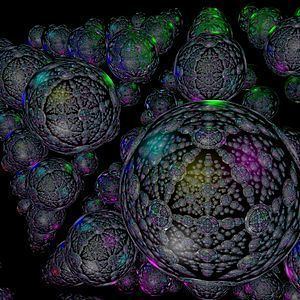 | ||
Talk on his the book indra s net by rajiv malhotra in bangalore
Indra's net (also called Indra's jewels or Indra's pearls, Sanskrit Indrajāla) is a metaphor used to illustrate the concepts of Śūnyatā (emptiness), pratītyasamutpāda (dependent origination), and interpenetration in Buddhist philosophy.
Contents
- Talk on his the book indra s net by rajiv malhotra in bangalore
- Indra s net the illusion of separteness
- Huayan school
- Proto Skhya and early Buddhism
- Indra and the world column
- Displacement of Indra by Vishnu and Shiva
- Associated meanings of the vertical column
- Atharva Veda
- References

The metaphor of Indra's net was developed by the Mahayana school in the third-century Avatamsaka Sutra and later by the Huayan school between the 6th and 8th centuries.

Indra s net the illusion of separteness
Huayan school

"Indra's Net" is the net of the Vedic god Indra, whose net hangs over his palace on Mount Meru, the axis mundi of Hindu cosmology and Hindu mythology. Indra's net has a multifaceted jewel at each vertex, and each jewel is reflected in all of the other jewels. In the Avatamsaka Sutra, the image of "Indra's net" is used to describe the interconnectedness of the universe:
Far away in the heavenly abode of the great god Indra, there is a wonderful net which has been hung by some cunning artificer in such a manner that it stretches out infinitely in all directions. In accordance with the extravagant tastes of deities, the artificer has hung a single glittering jewel in each "eye" of the net, and since the net itself is infinite in dimension, the jewels are infinite in number. There hang the jewels, glittering "like" stars in the first magnitude, a wonderful sight to behold. If we now arbitrarily select one of these jewels for inspection and look closely at it, we will discover that in its polished surface there are reflected all the other jewels in the net, infinite in number. Not only that, but each of the jewels reflected in this one jewel is also reflecting all the other jewels, so that there is an infinite reflecting process occurring.
This metaphor plays an essential role in the Chinese Huayan school, where it is used to describe the interpenetration of microcosmos and macrocosmos. Fazang (643–712) used the golden statue of a lion to demonstrate the Huayan vision of interpenetration to empress Wu:
In each of the lion's eyes, in its ears, limbs, and so forth, down to each and every single hair, there is a golden lion. All the lions embraced by each and every hair simultaneously and instantaneously enter into one single hair. Thus, in each and every hair there are an infinite number of lions... The progression is infinite, like the jewels of Celestial Lord Indra's Net: a realm-embracing-realm ad infinitum is thus established, and is called the realm of Indra's Net.
Proto-Sāṃkhya and early Buddhism
The concept of "Indra's net" has its philosophical roots in early proto-forms of Sāṃkhya.
Indra and the world column
The Sāṃkhya hermeneutics, associated with Yoga practices, teach that cognition is a vertical "protam" (the thread that runs vertically through a loom, the "warp"), and that phenomenal (i.e., spatial) nature is the dynamic, visible, horizontal "woof" or "weft" that shuttles back and forth across the loom, in three "colors", of white/yellow/gold, red/brown, and blue/black. These three colors correspond to the triguṇa theory, composed of sattva (goodness/quiescence/existence), rajas (passion/activity), and tamas (darkness/morbidity).
Earlier phases of this view are less discrete, but can be glimpsed in descriptions of Indra in the Vedas as the vertical skambha, or world column, which is also associated with the motionless timeless center of the universe, the axle of the world-wheel. Approaching the felly of the wheel, one experiences the passing of Time, but approaching the center, no experience passes at all, a state in Sāṃkhya called kaivalya (isolation). This isolation is said to free one from duḥkha (literally, a 'broken or disjointed axle', but which comes later to simply signify "suffering" in all its varieties).
It is also likely that Indra's depiction as a chariot-driver, reins in hand, helped to reify the image of the threads that comprise the net, since it is with these reins that Indra causes the world to revolve.
Displacement of Indra by Vishnu and Shiva
During the Upaniṣadic period (c. 1000 BCE – 200 AD), the Vedic god, Indra, was semiotically displaced by Viṣṇu (often translated as "the all-pervading one") and Śiva (the "auspicious one"), likely owing to the former's early associations with both the cyclical year (the felly of the world-wheel of Time) and its central axis, probably owing to the latter's early associations with Mt. Kailāśa, a beautiful, but virtually unscalable mountain in the Himalayan region thought to be the world-pillar.
Buddhism developed as another branch of the shramanic traditions halfway through this period, and later Buddhists, such as those living in the 3rd century CE, tended to identify more so with the older elements than with any that rose up afterward. This is, of course, not universally true, and numerous other elements of Hindu/Buddhist philosophy continued to interpenetrate throughout the course of South Asian history even up to the contemporary period.
Associated meanings of the vertical column
The "vertical" element of Time (kāla) emerges from the tendency to regard the north as identical to the celestial north (uttara, literally, "upper"). For Indians, living in the lower half of the Northern hemisphere, the world was regarded as a mountain, around which the sun traveled on its daily course. This revolution constituted one of the fellies of the wheel of Time, and designated the northern axis as the universal axis, sometimes called the world column, or "spine" (skambha). This vertical direction was at some point associated with the pinnacle (kūṭa) of reality, a motif that can be seen again in the Tibetan Buddhist kāla-cakra-tantra, the "loom of the wheel of time".
As Time is here regarded in its psychological sense, that of having a notion of past, present, and future, and as "persistently standing in the present", this vertical column was also associated with consciousness (the Sāṃkha system uses the term, kṣetra-jña (knower of the field), or just jña (knower)). In effect, this allowed for the identification of psychological time with World-Time (mahākāla). For South Asian metaphysicians, this explained how the soul (ātman) was able to live eternally, being but one of the measureless strands of eternal Time. Yet in Buddhist metaphysics, Time's non-phenomenality, along with its role as a limiting, destructive factor with respect to all spatial entities implied that the ātman itself was "empty of any permanent phenomenal content" (śūnyata). Conceptually, the "vertical world axis", understood previously as the un-fatiguable, eternal master of mortality, gave way to "Time, the emptiness of all phenomenality".
Atharva Veda
According to Rajiv Malhotra, the earliest reference to a net belonging to Indra is in the Atharva Veda (c. 1000 BCE). Verse 8.8.6. says:
Vast indeed is the tactical net of great Indra, mighty of action and tempestuous of great speed. By that net, O Indra, pounce upon all the enemies so that none of the enemies may escape the arrest and punishment.
And verse 8.8.8. says:
This great world is the power net of mighty Indra, greater than the great. By that Indra-net of boundless reach, I hold all those enemies with the dark cover of vision, mind and senses.
The net was one of the weapons of the sky-god Indra, used to snare and entangle enemies. The net also signifies magic or illusion. According to Teun Goudriaan, Indra is conceived in the Rg Veda as a great magician, tricking his enemies with their own weapons, thereby continuing human life and prosperity on earth. Indra became associated with earthly magic, as reflected in the term indrajalam, "Indra's Net", the name given to the occult practices magicians. According to Goudriaan, the term indrajalam seems to originate in verse 8.8.8 from the Atharva Veda, of which Goudriaan gives a different translation:
This world was the net of the great Sakra (Indra), of mighty size; by means of this net of Indra I envelop all those people with darkness.
According to Goudriaan, the speaker pretends to use a weapon of cosmical size. The net being referred to here
...was characterized there as the antariksa-, the intermediate space between heaven and earth, while the directions of the sky were the net's sticks (dandah) by means of which it was fastened to the earth. With this net Indra conquered all his enemies.
